Tags
4130, a. homer hilsen, B&M Luxos, bar-end shifters, Berthoud, bike commute, Boxy Rando, Cycles Toussaint, cypres, double butted, Gran Bois, Hetre, low-trail, nitto, noodles, planing, randonneur, Rawland, rene herse, rivendell, rSogn, shimmy, SPD, Velo Routier
I’ve been riding the Cycles Toussaint Velo Routier for a few days – have about 50 miles on it so far. I wanted to collect my thoughts as this is a new geometry and tire size for me. As for the rest of it, it’s very similar in size, weight, and materials (steel) to my A. Homer Hilsen. I’ve used a nearly identical build for the bikes, as well. Both have Nitto Noodle 41cm bars wrapped in cotton tape, both have the Rene Herse cranks, and both are within a few millimeters of dimension for fit. the main difference is the wheel size, tires, and geometry with the Velo Routier being a “low trail” and the Hilsen a “mid-trail” ride. OK – getting to the gut reaction first.
The Hetres really smooth out the ride on my rather bumpy commute. Although I’m on bike trails most of the time, my commute has a number of rough spots with roots pushing up the pavement on the trail, as well as general poor road maintenance in other spots. The Hetres feel smoother as you would expect. They have more air volume, and I have them pumped to 40psi rear, 30psi front. Comparing this to the Cypres tires on the Hilsen at 65psi rear and 45psi front, it should be more forgiving.
The bike feels just as fast. This is gut, so I will watch my commute stats over a longer timeframe. The first few rides are inconclusive as I’ve been more tired than usual. The ride times between bikes are within a few minutes out of an hour commute home.
I can really feel the handling differences in the low-trail – and it is not as disruptive as some of the lit I’ve read. The closest analogy I’ve heard is that “you steer with your bars” on the low-trail bike, whereas on the Rivendells, you “steer with your hips”. This seems accurate to me. I can ride this bike no-handed. It’s not easier to do this than the Rivendell – if anything it is just slightly more apt to wander around, but this may just be my lack of experience on this type of geometry. The interesting part is the feel with a front load. It is much more planted with a bag and a few pounds up front. It also wanders less when going slow, and of course there is much less issue with wheel flop when the bike is stationary. The ride feel is subjectively better with this setup for me. I really like having a front rando bag for longer rides. I can do nearly everything I need to do with all the gear within easy reach. This all said, I was doing fine with the Hilsen and the front rando. I just feel that the Toussaint “feels” more planted with this setup while riding.
As I said earlier, the Hilsen and Velo Routier are set up proportionally identical for my fit. Both bikes feel like a good steel bike should. Solid, compliant, light enough. Both are also beautiful in their own way. The Hilsen will win this battle, but the Toussaint is very nice looking in white with stainless Berthoud fenders and subtle red/yellow decals.
I haven’t had any shimmy issues with either bike. The Velo Routier tracked like a steam engine on a 30+ mph descent, and I rode shimmy-free no-handed from 15-25 mph. This seems to be the sweet spot for shimmy. I know the tubing on the Toussaint is double-butted 4130, with .9/.6/.9 top, seat, and down tubes on my size “large” frame. The smaller sizes are .8/.5/.8. This is not the “ultra-light” planing grade tubing that Jan Heine tends to like, and some of the Rawland bikes are built to, but I’ve ridden an rSogn, and it felt as stiff as this frame. Perhaps I need more sensitivity training. In any case, it rides really well, and I feel totally comfortable on this bike. A longer test ride is due, and luckily this is all set and ready for the upcoming brevet season starting next week!
Other comments on the build? I had no problems getting the build done – there were no flukey gonzo issues like misalignments, or gummed up threads. The hanger was straight, the fenders were already mounted, as were the brakes. I ended up tightening up the fender alignment to match up the Hetres as it originally had 38mm Somas on it, but that was the biggest time suck. I honestly had the thing built in a few hours, and I was taking my time. It helped that I had a cockpit set up from a previous build – nice not to have to wrap the bars. One note – I originally had SPD pedals, but put VP flats on it for the beginning of the season. I want to try these on longer rides to see if I have a knee issue that bothered me last year with the clipless pedals. I also migrated the 9-speed cassette and downtube shifters back to an 8-speed setup with bar-end shifters. Oh, I also put the B&M Luxos dyno light on this bike for the season.
One more item I forgot to add – I was very worried about what kind of front rack to use. The center-pull Dia Compe 750 brakes leave very little room and the normal rando-standard Nitto Mini rack wouldn’t work. Luckily, Cycles Toussaint has this figured out. They have a special rack made just for this bike. I exchanged emails (actually, blog comments) with Evan at Cycles Toussaint, and ordered it after I got the frame. It arrived a few days later just in time for my build. It fit perfectly with rear mounts that fit to the fork crown mounting screws. The rack holds my Tall Boxy Rando bag from Acorn at just the right height – the top even with my bars. Super happy with this. It is also possible to saw the rear arms off, bend the lower support arms, and mount the rack to the fender at two points if you want a lower platform and a more “constructeur” touch as Evan did with his personal bike.
Now it’s time to put some miles on this guy (and try not to forget my other bikes in the process).

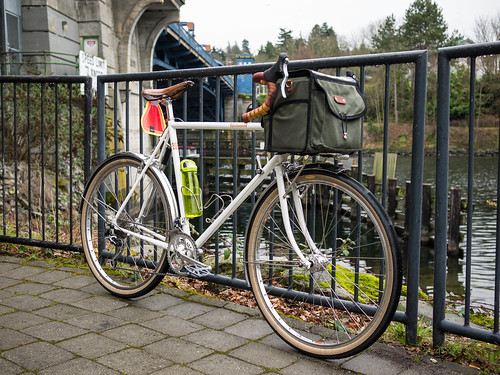
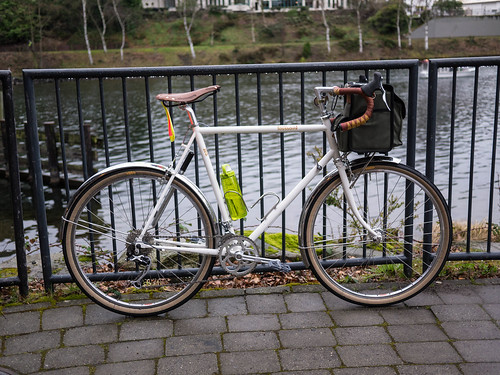
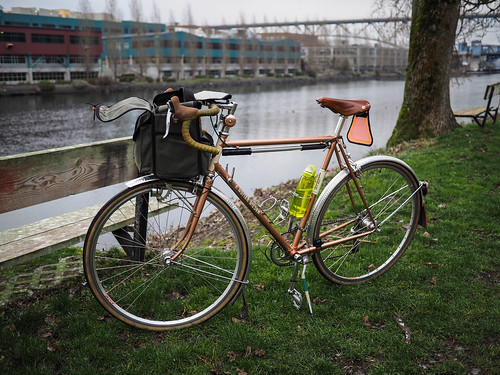
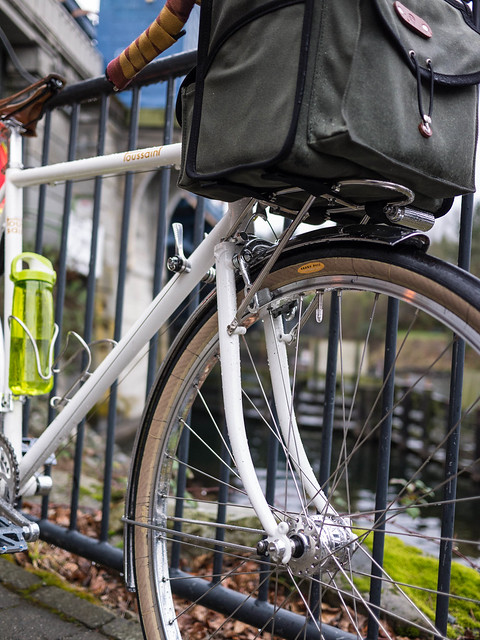
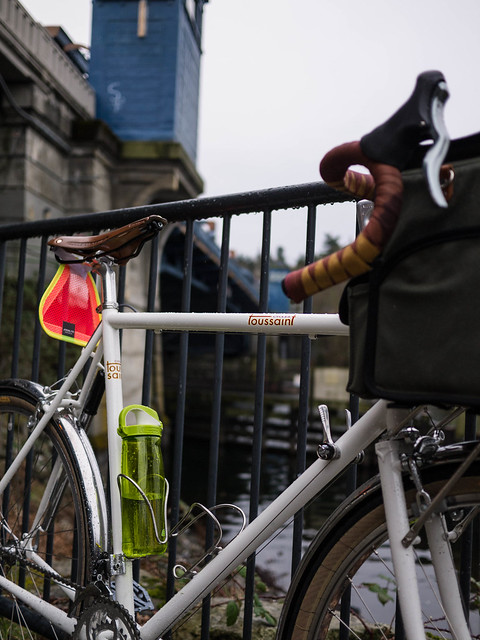

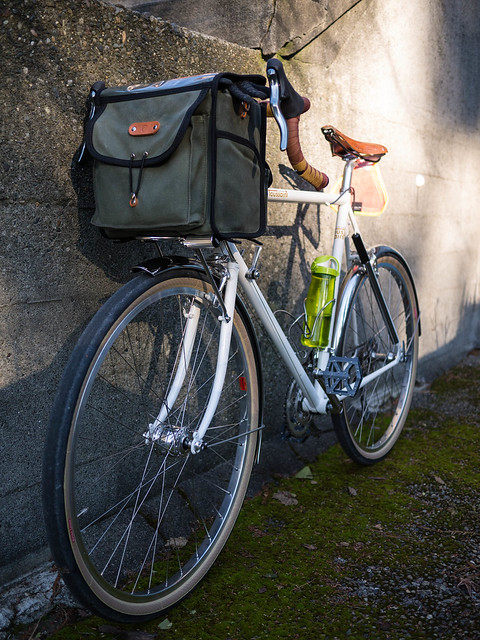
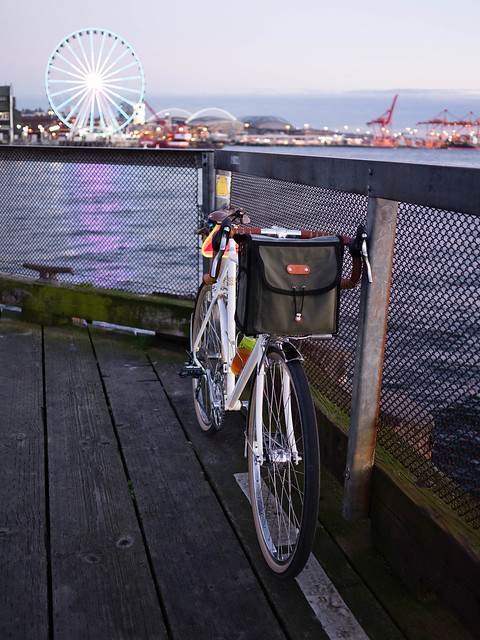
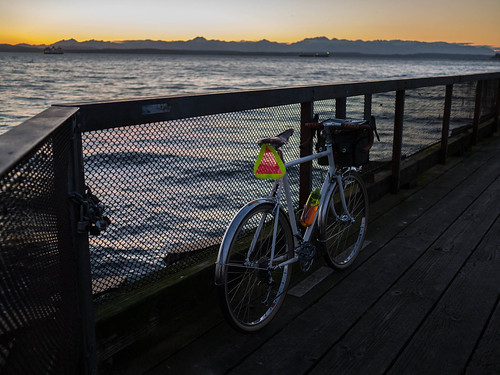
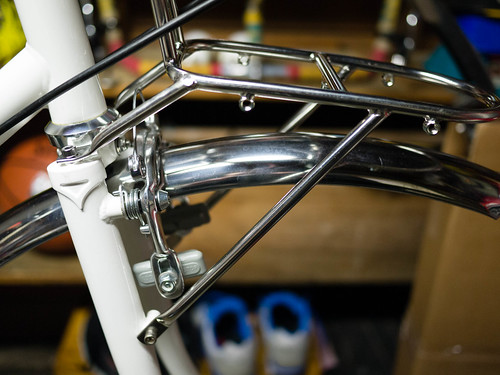
I’m getting ready to build up a Velo Routier V2, but am unable to locate a pump that fits in the seat stay pegs! I *think* that the Zefal Lapize might fit, and am curious what you are using, is it a Lapize?
-William
Great question! It is definitely a Zefal. I will see if I can find the label.
Pingback: First Prep Ride | Cycle Seattle
Hi Brian, nice build. Wondering if you could share your saddle heights in millimeters. This is a 57cm frame right? Just trying to get a visual on where my bars would be in relation to the saddle. Thanks for your time.
755mm. I am setting saddle height around 75-76cm these days.
I’m curious what you think of the Dia Compe 750 brakes? I have them on a 650b conversion and I pretty underwhelmed with the stopping power. I’m wondering if having them mounted on brazed-on posts improves the performance.
I’ve locked both tires up on dry pave in a panic stop with them. They don’t have the “power brakes” feel of V’s or disc, but they have great modulation and are there when I need them. I like ’em.
Evan – just did my first brevet (100k) yesterday and had no issues other than a glass flat on the rear Hetre. It rode really well, and I certainly wasn’t any slower than I’ve been on my 700c bike. Nice job on the design! Now I just need internal wire routing and superlite tubing for my meager weight 🙂
Awesome … love to hear stories of the VR on the road. Working on the SL version in stainless steel, with any luck for delivery in spring 2015 but don’t cross your fingers. We have been waiting for prototypes to be made up for a while and we are not on the priority list as we are low volume customer. Might be about 400-600 grams lighter but the internal wiring will be something I have to ponder 🙂
When we were designing and test riding our prototype frames we wanted a “shimmy-free, no-handed” ride with a loaded handlebar bag on all frame sizes so after some deliberation, for the larger frames (57cm and 60cm), we went with 9/.6/.9 tubing. So your observation tracking like a “steam engine” is a nice independent confirmation.
BTW I’ve gotten my personal 54cm VR up to over 80 km/hr with a Velo Orange handle bar bag ( about 3 kg loaded) and a Carradice Saddle (about 8 kg loaded) over Sunwapta Pass (elevation 2027m) here locally with no high speed shimmy or wobbles. I am 5’9″ but with a 195 lbs mesomorphic build so I’m no light weight and have had my share of clamping down on top tubes with my knees to stop high speed shimmy on some of my 700c road race bicycles (with no loads/bags/racks) in the past.
It’s been interesting introducing low trail, 650B bikes here locally to a wide range of cyclists; from experienced road racers to weekend path riders looking to upgrade from a hybrid clunker. Low trail bikes are pretty well non-existent around these parts so I too use the same analogy that “you steer with your bars” on the low-trail bike vs. you “steer with your hips”to explain the ride. The general feedback has been rider adaption has been minimal and the “ride and feel” is a “pleasant revelation”, in particular the stable ride with a front load.
Pingback: Stonehog Velo Routier Build Review | Ride Your Journey
Nice bike and nice build! It’s interesting to hear your thoughts on frame geometry and low trail vs. mid trail. I prefer low trail bikes for a commuting environment but find that I don’t care so much about trail when using a bike on long rides or in rougher terrain. Your photos are wonderful and I look forward to a long term update.
Thanks, Nola – I’m looking forward to a few longer rando rides in the next month. It will really be interesting to compare with my other bikes as I’ve gotten so used to the Rivendell geometry.
Looks good! What’s your drivetrain set up? I see you’ve got the R.H. 44/26 double, but what about the cassette and rear derailieur? Looks like a long cage? What are your gearing options with this set up, and why did you select it?
I’m considering rearranging my set up and any thoughts about your drivetrain build would be helpful.
Thanks.
John
Chainrings are 44/28, and the cassette is 8-speed 11-30. Rear derailleur is a recent 10-speed XT that I had laying around for the build. The range on this setup gives me 24-104 gear inches which is plenty wide for my commute which includes some 12% grades. If I spin out going downhill (rare) I’ll coast 🙂 I tend to shoot for something in the low 20s up to the mid-high 90s as a range and tend to stay in the high 60s to low 70s on the flats. On shifting duty, I’m using Shimano bar-end 8-sp shifters. I started out with a 9-speed setup, but the crank is picky with the narrower chains, and I was getting some chain suck.